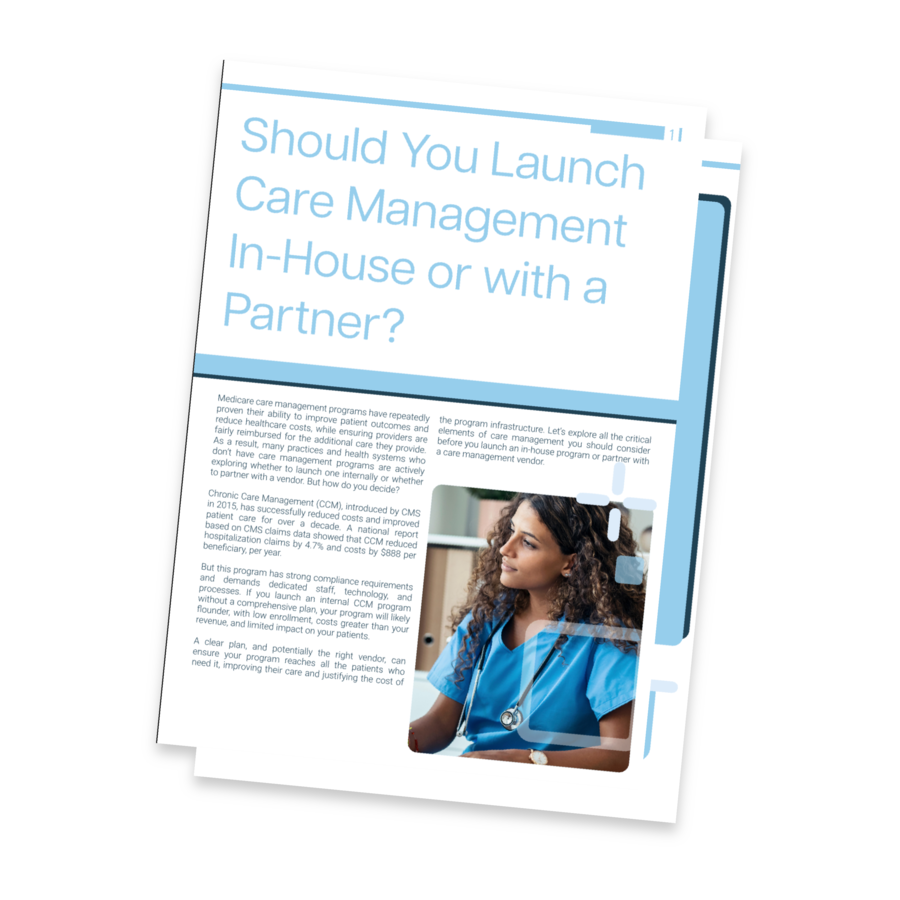
Talk with a ChartSpan Representative Today!
Our team is ready to help you improve patient care and outcomes.
Blog
How to Reduce Hospital Readmissions through CCM & APCM
Hospital readmissions remain one of the most persistent challenges in healthcare, both financially and clinically. They drive up costs for patients and payers while signaling potential gaps in care coordination and follow-up.
In fact, readmission rates are widely recognized as a key measure of care quality, particularly for hospitals serving older adults and patients with chronic conditions. Historically, about 20 percent of Medicare beneficiaries discharged from the hospital were readmitted within 30 days, reflecting the ongoing difficulty of maintaining health and continued care after an acute episode.
To address these rising costs and quality concerns, the Centers for Medicare & Medicaid Services (CMS) launched the Hospital Readmissions Reduction Program (HRRP) in 2010 under the Affordable Care Act. The initiative introduced financial penalties for hospitals with higher-than-expected readmission rates, driving measurable progress over time.
Despite these gains, readmissions still cost the U.S. healthcare system billions of dollars each year. Additionally, for older adults, each hospital stay adds further health, social, and financial strain.
Understanding what drives readmissions and how programs like Chronic Care Management (CCM) and Advanced Primary Care Management (APCM) can help prevent them is key to improving outcomes while reducing healthcare costs. In this article, we’ll address several causes of hospital readmissions and strategies for reducing readmission rates in your healthcare system.
What causes hospital readmissions?
Hospital readmissions are most often caused by poor care coordination, inadequate discharge planning, and delayed follow-up care. These preventable issues create gaps that lead patients back to the hospital, driving up costs and signaling shortcomings in care quality. While some readmissions are unavoidable, identifying and addressing these drivers is key to improving long-term patient outcomes.
Limited preventive care capacity
When providers are stretched thin, immediate needs take priority over preventive care. This leaves patients, especially those with chronic conditions, without consistent monitoring or proactive outreach. Missed opportunities for early intervention can lead to worsening symptoms, avoidable complications, and ultimately, hospital readmission.
Insufficient patient education
Patients who don’t fully understand their diagnosis, treatment plan, or self-management instructions are less likely to follow them after discharge. Clear, reinforced education is critical for helping patients recognize symptoms, take medications correctly, and follow lifestyle or therapy recommendations. When patients leave the hospital without this understanding, they’re at higher risk for complications that can lead to readmission.
Weak transitional care
The transition from hospital to home is a high-risk period. When discharge plans aren’t clearly communicated, or when patients lack the resources or support to follow them, care gaps quickly emerge. Missed medications, unmanaged symptoms, or follow-up delays can all trigger a return to the hospital within days or weeks of discharge.
Fragmented care coordination
A lack of communication between hospitals, primary care providers, specialists, and post-acute teams often leads to errors and missed information. Inadequate handoffs disrupt continuity of care, increase the risk of medication errors, and make it harder to monitor patients’ progress after discharge.
Medication or procedure complications
Medication-related issues, such as side effects, interactions, or dosing errors, are a frequent cause of readmission. Likewise, complications from surgical or other hospital procedures can lead to infections or other adverse events. Robust medication reconciliation, patient education, and monitoring are critical to reducing these risks.
Premature discharge
Pressure to manage capacity can sometimes lead to patients being discharged before they’re clinically ready. Without sufficient recovery time or a comprehensive care plan, symptoms may worsen or recur. Basing discharge decisions on thorough clinical readiness assessments can help prevent avoidable readmissions.
Inadequate follow-up
Post-discharge follow-up is one of the strongest defenses against readmission, yet it’s often inconsistent or delayed. Without timely outreach—through phone calls, care coordination, or Chronic Care Management or Advanced Primary Care Management—early warning signs can be missed. Consistent follow-up allows providers to identify and address issues before they escalate.
Social Determinants of Health (SDOH)
Challenges such as limited transportation, food insecurity, unstable housing, or lack of social support can prevent patients from following care plans or attending follow-up appointments. These social barriers significantly increase the risk of readmission.
By addressing SDOH, connecting patients with resources, transportation, or community support, providers can help reduce readmissions and support patients’ ability to manage their health after discharge.
Who is at risk for hospital readmissions?
Readmission rates vary widely depending on the patient population, including their geographic location and the type of care received during hospitalization. For example, patients discharged from certain departments, such as cardiology or pulmonary care, often face higher risks than others. Still, several consistent factors have been shown to increase the likelihood of readmission across healthcare settings.
Patients at higher risk for hospital readmission include:
- Those with multiple chronic conditions. Managing more than one long-term illness makes it harder to maintain stability after discharge and increases the likelihood of complications.
- Individuals living in rural or disadvantaged areas. Limited access to healthcare services and transportation often leads to delayed follow-up care or missed appointments.
- Patients with low education levels or language barriers. Difficulty understanding discharge instructions or medication guidelines can hinder adherence to care plans.
- Older adults experiencing frailty syndrome. Factors such as malnutrition, low mobility, risk of falls, cognitive decline, and functional dependence raise vulnerability to readmission.
- Patients with longer or recent hospital stays. Extended hospitalizations or frequent admissions often signal more complex health needs and a higher probability of returning to the hospital.
Are patients with chronic conditions at a higher risk?
Patients with chronic conditions are considerably more likely to experience hospital readmission, especially those managing multiple conditions at once. Diseases such as COPD, kidney disease, diabetes, cardiovascular disease, and hypertension are among the leading contributors to readmission risk. When more than one of these conditions is present, the likelihood of readmission becomes even greater, along with the cost per stay and overall mortality rates.
For many chronically ill patients, readmissions aren’t directly related to the original hospital intervention but rather to the complex, interconnected nature of their comorbidities. Managing one condition effectively doesn’t always prevent complications from another. This is why healthcare organizations must take a more holistic approach—one that extends beyond the acute episode of care to include ongoing support, proactive monitoring, and consistent patient engagement.
Chronic Care Management and Advanced Primary Care Management programs are designed to fill these gaps, providing continuous oversight and communication between patients and their care teams. By coordinating care and addressing underlying risk factors, these programs can reduce avoidable readmissions and improve quality of life for patients with chronic illnesses.
Strategies for decreasing hospital readmissions
Lowering hospital readmission rates is key to maintaining patients’ health and trust, reducing healthcare costs, and ensuring resources are used efficiently. While no single solution prevents readmissions, a coordinated strategy across multiple areas of care can dramatically lower risk.
Strengthen discharge management
A safe discharge begins well before a patient leaves the hospital. Thorough discharge planning ensures patients understand their care instructions, have access to medications, and know who to contact if symptoms worsen. Providing clear, written plans and confirming comprehension, especially for older adults or those with complex conditions, reduces confusion and improves follow-through after discharge.
Identify and support high-risk patients
Reducing readmissions starts with knowing which patients are most at risk. Individuals with multiple chronic conditions, frequent hospitalizations, or limited social support often need more attention after discharge.
By identifying these patients early and offering proactive support—such as care coordination programs, remote monitoring, or regular outreach—providers can catch complications before they become emergencies and help patients stay on track with their care plans.
Provide comprehensive patient education
Patient education is one of the most effective tools for reducing preventable readmissions. Clinicians should take time to explain diagnoses, treatment plans, and follow-up care to patients and their families in clear, accessible language. Reinforcing instructions through written materials or digital communication helps patients retain information and feel confident managing their care at home.
Address Social Determinants of Health
Socioeconomic factors can affect a patient’s ability to follow care plans after discharge, making it difficult to pick up prescriptions, follow dietary recommendations, or attend follow-up appointments.
Providers can reduce readmissions by ensuring patients receive the help they need to navigate these challenges. This may include connecting patients with community resources, arranging transportation, or providing regular outreach and check-ins to help patients stay on track with their care.
Implement medication reconciliation interventions
Medication errors and interactions are common causes of readmission. Conducting thorough medication reconciliation before discharge, and again during follow-up, helps ensure that patients understand which prescriptions to continue, stop, or adjust. Including pharmacists or care coordinators in this process provides an added layer of safety.
Improve care coordination
Effective communication between all branches of a patient’s care team is essential for maintaining continuity of care. Shared care plans, up-to-date medical records, and consistent follow-up protocols help close gaps that can lead to readmission. When all providers work from the same information, patients experience smoother transitions and better outcomes.
Maintain post-discharge communication
Early follow-up after discharge is critical for preventing complications that can lead to readmission. Checking in with patients allows care teams to clarify instructions, address new or worsening symptoms, and reinforce medication adherence.
Whether through phone calls, text messages, or virtual visits, timely communication helps uncover barriers, such as missed appointments or confusion about treatments, before they escalate. Consistent outreach ensures patients feel supported and strengthens continuity of care outside the hospital setting.
How to reduce hospital readmissions with ChartSpan
Reducing readmissions isn’t just about preventing the next hospitalization; it’s about transforming how preventive care is delivered. ChartSpan’s Chronic Care Management (CCM) and Advanced Primary Care Management (APCM) services integrate prevention into every step of the patient journey, ensuring continuous support rather than one-time interventions.
When APCM was introduced, CMS included support after inpatient discharges as one of its key components. ChartSpan provides proactive APCM discharge management designed to keep patients engaged during one of the most vulnerable points in their care. When a patient enrolled in APCM is discharged, automated notifications alert ChartSpan’s team right away. Even for healthcare organizations that aren’t part of a national network, ChartSpan can establish custom systems for discharge tracking and outreach, ensuring no patient goes without post-hospital support. Within three business days, a care manager reaches out to help patients schedule a follow-up appointment with their provider, review their discharge instructions, and identify any obstacles that could disrupt recovery.
If a patient needs transportation to an appointment, assistance getting medications filled, access to food that aligns with their dietary needs, or durable medical equipment at home, ChartSpan helps coordinate those resources, bridging the gap between discharge and recovery to reduce the risk of readmission.
CCM patients also benefit from ChartSpan’s transitional support. While full discharge management is not a required element of CCM, ChartSpan’s care managers are equipped to step in when patients report a recent hospitalization. They review discharge instructions, offer relevant educational materials, confirm access to medication, and help schedule provider visits or arrange transportation. These ongoing touchpoints help patients manage the conditions that led to hospitalization and prevent them from returning unnecessarily.
Proven results
ChartSpan’s APCM and CCM programs deliver measurable improvements in both patient outcomes and cost efficiency. By combining preventive care, post-discharge outreach, and patient engagement, ChartSpan helps healthcare practices and systems reduce readmission rates and lower the cost of care.
- Over a three-month period, ChartSpan assisted 35 recently discharged patients for a single client. Of those, 85.7 percent avoided readmission for 90 days.
- Across all clients, ChartSpan customers save an average of $205 per patient per month in healthcare costs, which is 277 percent higher than the industry average.
- In one practice, 8 percent of patients eligible for CCM but not enrolled were readmitted within 30 days, while only 4 percent of those participating in ChartSpan’s CCM program were.
Together, these results highlight the tangible impact of integrating preventive and transitional care into everyday practice: helping providers strengthen continuity of care, improve outcomes, and keep patients out of the hospital.
Simplify value-based care and reduce readmissions with ChartSpan
Managing value-based care requirements, like reducing costs and preventing hospitalization through preventive care, can be time-consuming for healthcare teams. ChartSpan handles the administrative and outreach components of CCM and APCM—including patient enrollment, monthly communication, and discharge management for APCM—so clinicians can focus on delivering high-quality, in-person care. This approach allows health systems to achieve measurable results in both patient health and operational efficiency.
Ready to reduce readmissions? Talk to a ChartSpan expert to learn how CCM and APCM can help your organization improve outcomes, strengthen patient relationships, and significantly reduce hospital readmissions.
You may also like:
Subscribe for More Insights
Get valuable resources delivered straight to your inbox.
"*" indicates required fields






